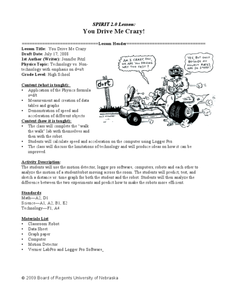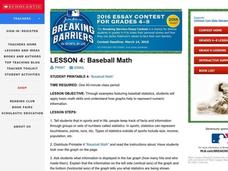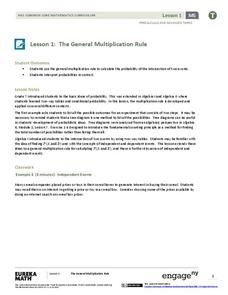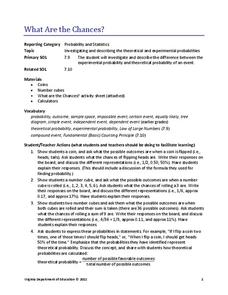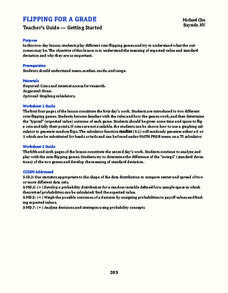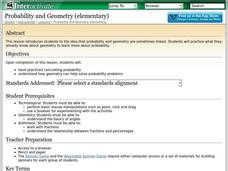Curated OER
Building Trades
Students complete a masonry project. They follow proper procedures to complete
multiple masonry projects, follow written and verbal instructions, apply proper masonry techniques, and correctly calculate materials needed.
Curated OER
If .... Then Probably
Students are introduced to the concepts of probability and chance. Using data given to them, they organize and create a chart to display the information. Using this chart, they calculate the percentage of chance and probability and...
Curated OER
You Drive Me crazy
Students calculate the distance and acceleration of an object. In this algebra lesson plan, students collect data and create table and graphs to analyze it. They complete a lab as they collect and analyze data on acceleration and distance.
Curated OER
Baseball Math
Students collect data on baseball plays. In this statistics lesson, students graph their data and make predictions based on their observation. They calculate what the probability is that a favorable outcome would happen.
Curated OER
The Colored Cube Question
Fourth graders examine how to determine the probabilities or likelihood of outcomes. They complete trials to determine probability while using different manipulatives. They determine how games can be made fair or unfair in this unit of...
Curated OER
You May Already Be a Winner!
Second graders flip coins and tally the outcomes. They play the You May Already Be a Winner! game with cards under their chairs. Some cards are winners, some might be and the others are not. They play to explain the probability concept.
Curated OER
Chances Are: Talking Probability
Students explore probability and the process of data analysis and predictions. They participate in two activities, one involving a calculator and one the Internet, in which they make predictions and conduct activities to test their...
Curated OER
Football Statistics
In this math activity, students examine the statistical information as provided in the graphic organizer and calculate the other values.
Curated OER
Can You Guess
Students develop useful strategies for mental calculation when estimating possible addition solutions. They mentally perform calculations involving addition and subtraction. Students state the estimated sum or difference between numbers.
Curated OER
Natural Selection
Students practice calculating allele and genotype frequencies in the framework of a simple simulation using hard candy, calculators, and a worksheet. This activity includes a three-page worksheet and an assessment question for conclusion.
Curated OER
Sports Careers
Students research various sports careers, locate possible places of employment, and give an oral presentation of their findings.
Curated OER
Designing Models to Simulate Actual Events Using a Table of Random Digits
Students design models to simulate actual events using a tale of random digits. They estimate the likelihood of a particular outcome using results of simulation. Students investigate the uses of statistical methods to analyze data.
Curated OER
Penny's Box
Students need to be able to calculate the volume and surface area of a cuboid as well as present a systematic list of results in order to justify the minimum case. The use of three factors of 100 is also important.
Curated OER
How Far!
Fourth graders perform basic calculations using time. They read and construct a variety of scales, timetables, and charts. Students devise and use problem solving strategies to explore the situation mathematically.
EngageNY
The General Multiplication Rule
In the first installment of a 21-part module, scholars build on previous understandings of probability to develop the multiplication rule for independent and dependent events. They use the rule to solve contextual problems.
Shodor Education Foundation
Playing with Probability
Review basic probability concepts with your class using different-colored marbles in a bag. Then pair up learners and have them play a cool online interactive game in which they race miniature cars using the roll of a die or two. The...
EngageNY
Determining Discrete Probability Distributions 1
Learn how to determine a probability distribution. In the ninth installment of a 21-part module, future mathematicians use theoretical probabilities to develop probability distributions for a random variable. They then use these...
Virginia Department of Education
What Are the Chances?
Take a chance on an informative resource. Scholars conduct probability experiments involving coins and number cubes to generate data. Compiling class data helps connect experimental probability to theoretical probability.
Curated OER
Binomial Probabilities: Understanding Math
Although this binomial probabilities worksheet is based on a computer math program (Neufeld Learning Systems: Understanding Math), it can easily be used without the program. If you don't have the program, skip the first question. Young...
Curated OER
Flipping for a Grade
What happens when your teachers get tired of grading tests and want to use games of chance to determine your grade? How would you decide which game they should play? Learn how to use expected value and standard notation to compare two...
Curated OER
Mathematics of Fair Games
Students examine mathematicians' notion of fairness in games of chance. They work in pairs to perform three different experiments using macaroni and paper bags. They record their results on charts and compare their data.
Curated OER
Probability of a Single Event
For this probability worksheet, learners solve thirty-six fractional probabilities involving the rolling of a dice to specific scenarios, game spinners, sweets in a bag and random colors. Students check their answers online as they go.
Curated OER
Probability and Geometry
Students examine the relationship between probability and geometry to solve problems. In this geometry and probability lesson, students investigate the effect of changing percentages on a spinner to the probability of landing on a...
Curated OER
Probability
In this probability learning exercise, students explore theoretical probability, empirical probability, tree diagrams, and conditional probability. This twenty-four page learning exercise contains approximately 80 problems. Answers,...




